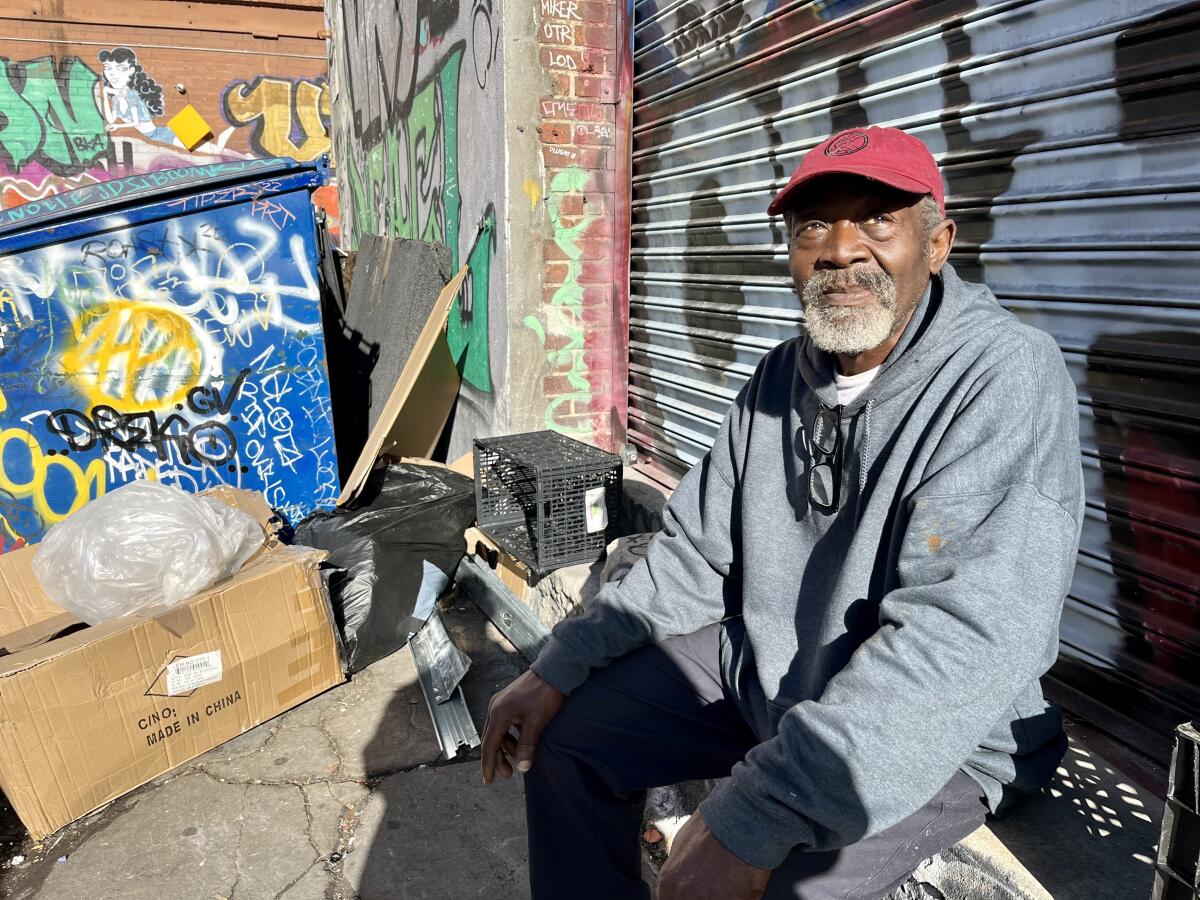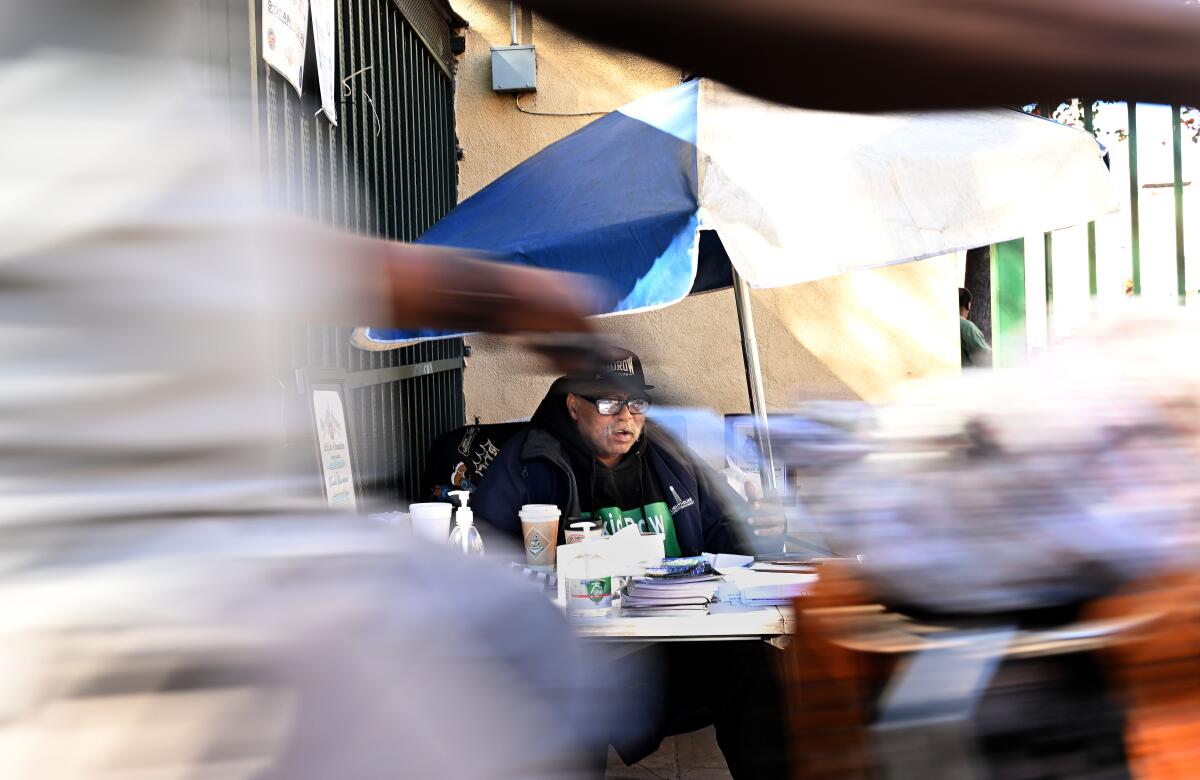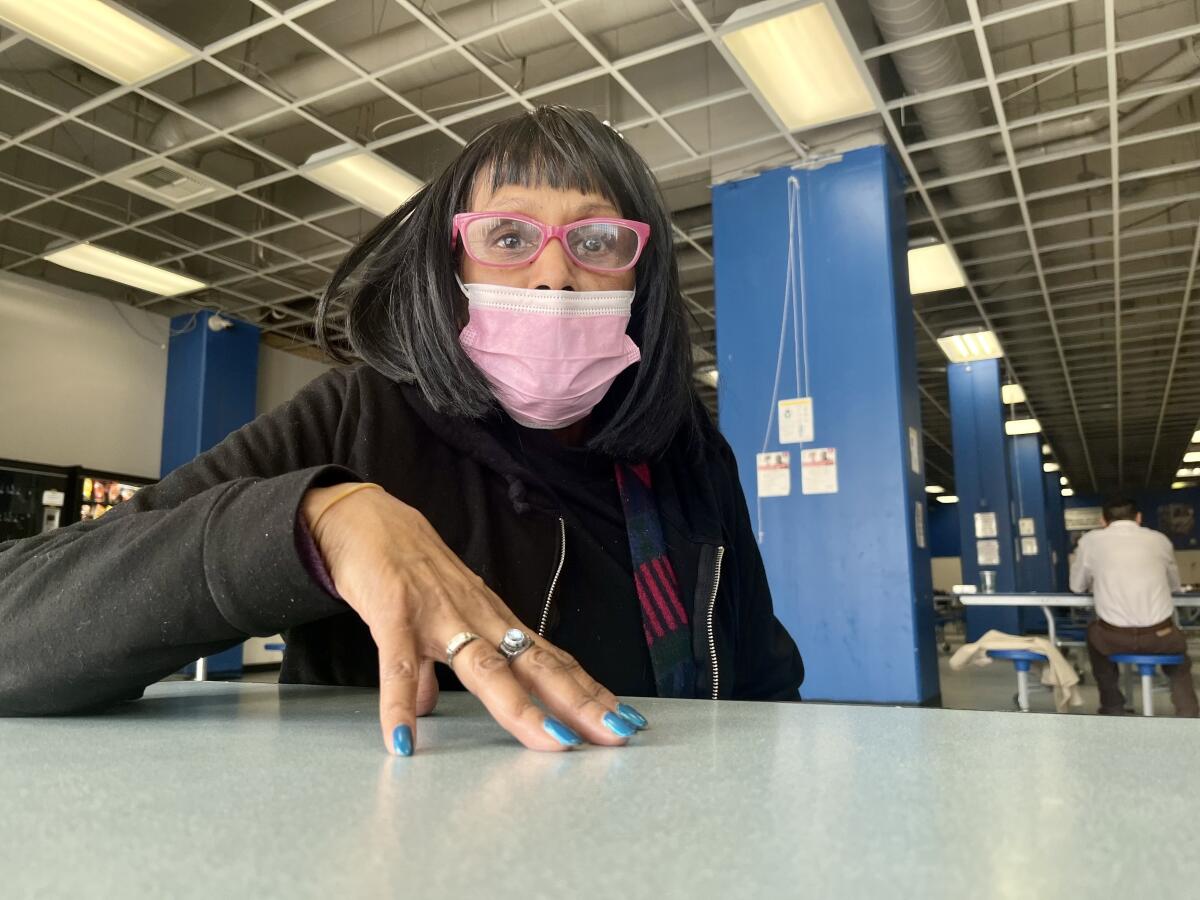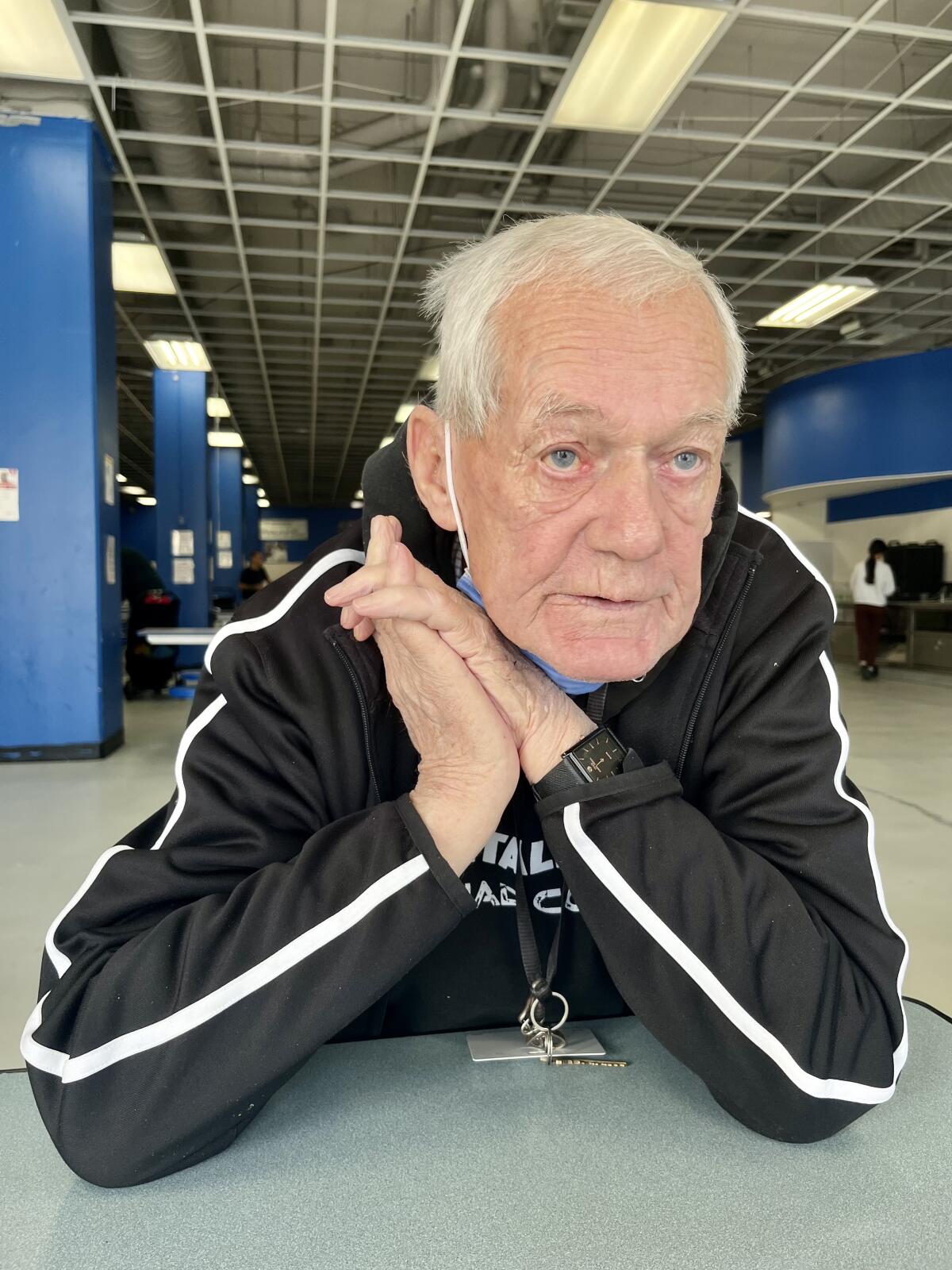Column: A vast, teeming retirement community called skid row

- Share via
Earlie King Jr. says he was in his late 20s when he took up residence in a skid row alley downtown.
He didn’t intend to grow old there, but that’s what happened.
When King finally moved indoors, about three weeks ago, he was 65. Leaving the Los Angeles alley, where he and friends scratched out an existence by unloading shipments to toy district merchants, felt like leaving home.
“That place just becomes a part of you,” King told me after we were introduced by Sieglinde Von Deffner, the skid row coordinator for L.A. County’s Housing for Health program, who got him into a nearby single-room occupancy building.
It’s a temporary arrangement, and King is hoping he’ll be able to move into a new apartment building nearby when construction is complete. But demand is far greater than supply, and King was homeless so long, the transition to living indoors is disorienting.
“I had trouble sleeping last night,” he told me. The mattress felt strange after spending half his life on a wooden pallet covered with cardboard.
Steve Lopez
Steve Lopez is a California native who has been a Los Angeles Times columnist since 2001. He has won more than a dozen national journalism awards and is a four-time Pulitzer finalist.
King’s gray stubble and uncertain future put him in good company on skid row. Based on information provided by government and nonprofit officials, roughly 2,000 older adults — a disproportionate number of whom are Black — live in tents, shanties, shelters and single-room occupancies. And in limbo.

“Skid row is the largest retirement center in the country,” said Wendell Blassingame, 74, who distributes masks, psalms and information on housing and social services from his volunteer post in the little park at 5th and San Julian streets.
There are of course larger retirement centers, but Blassingame, once homeless and now living in a single-room occupancy, meant it as a lament rather than literally. Growing old is challenging enough in a safe and pleasant environment. On skid row, the terrain is harsh, a drug market flourishes amid the squalor, and physical and mental distress are on parade. And women have the worst of it, Blassingame said, because of how they’re used and abused.
Older adults constitute one of the fastest-growing segments of the homeless population in California, even though life expectancy is considerably lower for people whose health rapidly deteriorates on the streets. And skid row — where roughly 17% of the homeless population is 55 and older, according to the latest count — is a good place to see where we’re headed if the state doesn’t prevail in its 10-year strategy to reverse high poverty rates, healthcare inequities and the housing affordability crisis that’s already pummeling older residents.
I asked the Rev. Andy Bales, who runs the Union Rescue Mission on San Pedro Street, if he knew how many older folks he was sheltering.
Two hundred and eighteen, and more are on the way, he said. “We are forecasting a tsunami of seniors and families with children.”
I wanted to meet some of the older adults and Bales opened the door to me.

“It’s a godsend,” said Margo Fitzsimmons, 66, an unemployed security guard who’d been living with a cousin in Inglewood. When he died, she became homeless.
She said she has a relative who might be inclined to let her “curl up in his living room, but his wife won’t have it.” Her car was too expensive to hold onto, Fitzsimmons said, and finding work without one is a big problem.
So is age discrimination. At one interview, she said, she was told, “We really don’t work with people in your age group.” She moved to the mission, where she shares a small room with another woman, three years ago.
“I’m still trying to move on,” said Fitzsimmons, who doesn’t feel safe on the streets of skid row. “I walk in faith that eventually something will happen…I’ll pull out of this because I’m healthy, I don’t smoke, I don’t do drugs.”
Michael Kelly, a 76-year-old college graduate and Canadian citizen, has been living at the mission for 10 years and earns a stipend for ushering patients to the mission’s dental clinic. Kelly told me he began drinking heavily as a young man and got hooked on pain medication, too. His marriage ended, he was treated for depression and held various jobs over the years, but “my drinking screwed it up.” Several rehab attempts failed until he finally got clean at the mission.

“I came here because I had nothing,” said Kelly, who saves up for occasional trips to the theater or the opera.
He told me he doesn’t see how he’ll ever be able to afford to live on his own. But he hasn’t stopped thinking about the possibility.
“I’ve got a vision of a house in the countryside with a stream, so I could do a little fishing,” he said. “That would be my dream.”
Michelle Steverson, 70, arrived at the mission two weeks ago. She did general office work and lived with a stepsister, but was asked to leave after losing her job — she blames it on age discrimination — and could no longer help out with the rent. She has no idea what’s next.
“I just try to be happy, and I’m looking for any opportunity,” Steverson said.
The scary thing is how many more people are on the verge of falling into the same predicament. After I spoke to Steverson, I heard from a 102-year-old World War II veteran who lives in a one-bedroom apartment in Hollywood. He said the bulk of his income goes to in-home care, and he just got hit with a $524 gas bill. He put his caretaker on the phone and she said she’s struggling as well, because pay is relatively low for home health aides.
“Everywhere you turn, gas bills are going up and people on fixed incomes could end up having to choose between the gas bill and housing,” said professor Donna Benton, a USC gerontologist who helped craft California’s Master Plan for Aging.
Benton is optimistic about strategies to address and prevent homelessness, but she doesn’t downplay the enormity of the challenges. She says heavier lifting is needed to raise wages, fight age discrimination and extend careers. And some form of long-term insurance is needed so that isolation, suffering and poverty are not so much a part of growing old.
Golden State: Columnist Steve Lopez’s series on California’s aging population
Dr. Heidi Behforouz, Housing for Health’s chief medical officer, doesn’t hold back when discussing what she sees as a collective shrug over the struggles of a population that’s treated as disposable.
“One mark of a civil society is that it takes deferential and better care of its people as they age, and we do that horrifically in this country,” said Behforouz. “We don’t have enough of a safety net system to catch people as they age who are becoming socially and fiscally disenfranchised.”
She said she’s trying to roll out three initiatives this year. The first would be to fortify the outreach teams that deliver medical treatment and social services to people in shelters and on the street; the second, to deliver long-term management to those who need it; and the third, to provide better palliative and hospice services to older adults nearing the end of their lives.
Getting someone like Earlie King into a room, Behforouz said, does not mean the work is done, because the goal is to help people thrive, not just survive.
King was a bit hesitant to take me to the alley where he used to live, but he thinks he needs to face his fears and convince himself that life is behind him. He showed me the spot against a red brick wall where he slept all those many nights, except when he got picked up on drunk and disorderly charges and did jail time.
All of this began, he said, when his wife died of a heart condition in her early 30s.
“That’s what set me off,” said King, who lost a job as a janitor, passed off his kids to relatives, and became one more anonymous face, disappearing into the cracks of skid row.
A bad urinary tract infection landed him in the hospital late last year. When he recovered, he met social worker Von Deffner and started down this new path, which gives him hope, but scares him, too.
King said he thinks about the lost years and the kids who grew up without him around. He’d like to get back in the picture, he told me, if that’s even a possibility. But first he has to work on himself.
“I’ve gotta do what I’ve gotta do,” he said.
More to Read
Sign up for Essential California
The most important California stories and recommendations in your inbox every morning.
You may occasionally receive promotional content from the Los Angeles Times.












